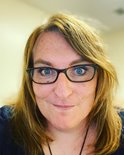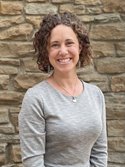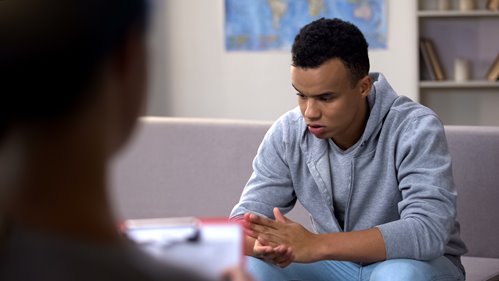Ensuring health equity for our rural LGBTQ+ neighbors

Tori Gleason, DC, DACBSP |

Carrie Henning-Smith,
|
As a child in Dodge City, Kan., in the 1980s, Gleason didn’t have many of the modern tools that help people explore the world and stay connected, namely social media and the internet. She struggled with mental health challenges and even attempted suicide at the age of 12. Her parents lacked insurance, so most behavioral health care providers were out of reach – and those nearby lacked experience with transgender patients. The advent of telehealth, she says, saved her life.
“Having access to behavioral health via telemedicine made me feel not so isolated,” she explains. “I felt a sense of community. It was my bridge to other people that had similar life experiences.”
In her professional life, Gleason has used her personal struggles to fuel her advocacy. She is passionate about increasing access to care for LGBTQ+ individuals in rural communities, and she believes education is key to helping all types of rural health care providers break down barriers and create more welcoming and inclusive spaces. She is regularly asked to teach and give trainings to health care professionals – and she almost always says yes.
“There is so much historical harm that has come to the LGBTQ+ community because providers didn’t get that education while they were matriculating through school,” she says. “A lot of my mission is to educate as many people as possible.”
‘Welcoming, affirming, and up to date’
During her time in Goodland, Gleason served on the hospital board for Goodland Regional Medical Center, a critical access hospital, and she is currently working as a clinical analyst at LMH Health in Lawrence, Kan., while she earns her master’s degree in public health and epidemiology from the University of Kansas. This has given her plenty of perspective on the types of education rural health care providers need – as well as how hospitals and health systems can better serve LGBTQ+ patients.
“Asking about sexual orientation and gender identity lets the patient know they’re safe and their intersectional identities matter,” she says. “Experiencing discrimination causes harm and makes people hesitant to seek care. It’s important to let people know their practices may affect health equity of LGBTQ+ populations. Care starts at the front door with onboarding and admissions staff – they need to be privy to education as well.”
NRHA member Carrie Henning-Smith, PhD, MPH, MSW, University of Minnesota School of Public Health Division of Policy and Management associate professor, has also done a significant amount of research on health and health care access for rural LGBTQ+ residents. With funding from the Federal Office of Rural Health Policy, Henning-Smith and her colleagues have been conducting a wide-ranging research project involving secondary data analysis of multiple national data sources, key informant interviews, and a series of case studies of promising models to support rural LGBTQ+ health.
She notes that rural LGBTQ+ populations face many of the same challenges accessing care as all rural residents – provider shortages, long distances to care, more limited broadband and transportation, and declining availability of hospitals and other health care facilities – but these common concerns are often compounded by outdated practices that come across as exclusive or discriminatory, such as making assumptions about a patient’s spouse or partner or ignoring a patient’s request to use their chosen name.
“Rural LGBTQ+ individuals face the additional challenges of finding welcoming and affirming providers who understand best practices around LGBTQ+ health,” Henning-Smith says. “If a provider or other staff in a health care facility isn't welcoming, affirming, or up to date on best practices, rural LGBTQ+ residents are often left with fewer alternative choices for care than their urban counterparts would be.”
Even worse, she says, facing discrimination or outright aggression in a health care setting can prevent or delay an individual from seeking needed care, resulting in worse health outcomes. According to NRHA’s recent policy brief on rural LGBTQ+ health, LGBTQ+ individuals tend to have a higher prevalence of mental health disorders and are less likely to disclose their sexual orientation or pursue treatment due to past discrimination. These disparities can be exacerbated in rural communities because of limited choices in health services and closer social networks.
“Without access to high-quality, timely, and affirming care, LGBTQ+ residents may go without necessary routine or preventive care and may have a harder time getting appropriate care during acute and emergency situations,” Henning-Smith says. “Experiencing homophobic, transphobic, or otherwise hostile environments in health care or other settings can cause chronic stress and other negative health outcomes.”
 |
Overcoming barriers to care
Because finding affirming care can be challenging in rural areas, organizations such as Out in the Open are stepping up to fill in the gaps. Based in Wyndham County, Vt., this nonprofit aims to address common health care barriers experienced by rural LGBTQ+ individuals through its Health Equity and Access for Rural TLGBQ+ (HEART) Program, which launched this spring. According to Jake McBride, Out in the Open health justice organizer, nothing else like it exists in the area, and in just a few months their volunteers have provided assistance to a significant number of patients.
McBride says the program was developed as a direct response to needs expressed by community members during virtual meetings that began during the pandemic. In response to an overwhelming amount of negative health care experiences shared by region’s large LGBTQ+ population, the grassroots group came up with the idea for a health-related advocacy organization. After two years of planning, Out in the Open was able to secure funding for the HEART Program, which above all aims to meet people where they are.
“We have a support request form where people can tell us what they need,” McBride explains. “We put the person requesting support in charge. My job is to say, ‘How can we best support you? Here are the resources we have.’ We’re not telling people what to do or making recommendations. This is a community-building program where everyone is helping each other.”
At the crux of the program is a peer-to-peer support system that offers assistance with health related needs, including transportation to and from appointments, referrals to LGBTQ+-friendly providers, and harm reduction strategies to mitigate the opioid epidemic, which is a significant concern in the area. Volunteers are also available to go to appointments with patients and serve as advocates, which McBride says can “completely change the dynamic of the experience.” The program offers training to volunteers who provide support – and often receive support themselves.
“There might be a volunteer who can help talk someone through a tough situation because they are a trans individual and have gone through the same thing, but they might not have a car,” McBride says. “They might request support to get to and from an appointment.” Though the program is relatively new, McBride says early feedback has been positive, with people expressing that they wish they’d had a similar network of advocates when they were experiencing health-related challenges or seeking affirming care as a trans person lacking support from their family of origin. They have also received a lot of feedback from people who want to use their expertise navigating the health care system to help other people.
“This program is not my dream for health care – it is a stopgap to get people the care they need and hopefully a step along the way to a way more supportive form of health care,” McBride says. “One thing we talk about a lot at Out in the Open is that rural areas are not always dangerous and scary for queer folks – we have a really tight-knit community that shows up for each other. It’s about how we rally the community to make sure everyone stays safe and happy and comfortable.”
Working toward health equity
While Henning-Smith notes that there has been considerable progress in LGBTQ+ health equity over the last few decades – including an expansion of research and funding focused on rural LGBTQ+ health – much work remains to be done.
“There is still a long way to go to ensure health equity for rural LGBTQ+ individuals,” Henning-Smith says. “This needs to include addressing the barriers to health care that all rural residents experience, but work is also needed to ensure care is safe, accessible, affirming, and inclusive for LGBTQ+ individuals in
rural areas specifically. This includes passing antidiscrimination legislation at the federal level and
providing training for anyone who works in a health care facility.”
NRHA’s policy brief outlines additional actions that can help work toward health equity, including creating policies that address discrimination, providing federal grant funding for rural health worker education, creating inclusive guidelines on pronoun use in health care settings, updating health information technology and electronic health records to include pronouns and gender identity, and collecting information and research on the health care challenges and outcomes experienced by rural LGBTQ+ individuals.
On a more informal, day-to-day basis, Gleason points out that a big part of the process is simply making a conscious effort and trying to do better.
“I make mistakes too – I have made assumptions about someone’s pronouns and gender identity,” Gleason says. “I’m still learning and engaging. Part of it is trying to do better – just apologize and do it differently next time. You’re going to make mistakes – but when we do we want to make sure we have corrective behavior and that we change things. By reducing those barriers and increasing access, we are able to take care of the whole patient.”
Additional resources
Focusing on education
Education is vital to achieving rural LGBTQ+ health equity, but many health care providers and staff do not receive training specific to these populations in school. That’s why the University of California San Francisco (UCSF) recently developed an LGBTQ+ Health Certificate Program, which is open to all UCSF staff, faculty, students, fellows, and residents. The first cohort included students from the schools of medicine, nursing, pharmacy, and physical therapy, with training focused on creating safe and inclusive
clinical spaces for LGBTQ+ individuals.
Annesa Flentje, PhD, UCSF School of Nursing associate professor and Center for Sexual and Gender Minority Health director, wanted to create an avenue for health care providers to receive more LGBTQ+-specific education in response to negative experiences she has witnessed, both in her research and within her own family.
“Health care spaces should be safe spaces,” Flentje says. “These are vulnerable places where you are asked to put your life in the hands of others. When experiences in those places are bad, it means people don’t return for the health care they need. The certificate program was our answer to helping health care workers and researchers get better at providing affirming care in their settings.”
In addition to doctors and nurses, educational opportunities are available for every person who interfaces with patients, including security guards, the scheduling desk, and all types of health care providers. Flentje says this type of education may be even more valuable in rural areas, where there are fewer health care providers and LGBTQ+ individuals may have a tougher time finding affirming care.
“With this certificate we aimed to teach people more than the basics of LGBTQ+ health and to empower them to go out and improve their own environment and setting,” Flentje says. “The number of barriers and problems at a system level is overwhelming, but by empowering individuals within the health care system to identify and change the problems we enable system change.”
Additional programs and resources
- HEART Program
- UCSF LGBTQ+ Health Certificate Program
- University of Minnesota Rural Health Research Center publications
- NRHA policy brief on LGBTQIOA+ health in rural America
- Virginia Rural Health Association’s Pride of Rural Virginia Program
- National LGBTQIA+ Health Education Center
- Human Rights Campaign health care equality index
- World Professional Association for Transgender Health
Why affirming care matters for LGBTQ+ youth
Research shows that working toward LGBTQ+ health equity and safe, inclusive, and affirming health care environments may be particularly impactful for young people.
- Sixty percent of youth who wanted mental health care in the past year were not able to get it:
https://www.thetrevorproject.org/survey-2022/
- 45 percent of LGBTQ+ youth seriously considered attempting suicide in the past year, nearly 1 in 5 transgender and nonbinary youth attempted suicide, and LGBTQ youth of color reported higher rates than their white peers:
https://www.thetrevorproject.org/survey-2022/
- LGBTQ+ youth are not inherently prone to suicide risk because of their sexual orientation or gender identity but rather placed at higher risk because of how they are often mistreated and stigmatized in society: https://www.thetrevorproject.org/survey-2022/
- Transgender and nonbinary youth who reported gender identity acceptance from at least one adult had 33 percent lower odds of reporting a past-year suicide attempt: https://www.thetrevorproject.org/blog/acceptance-of-transgender-and-nonbinary-youth-from-adults-and-peers-associated-with-significantly-lower-rates-of-attempting-suicide/
- More than 60 percent of LGBTQ+ youth reported their home was not affirming, and nearly 2 in 5 reported living in a community that is unaccepting of LGBTQ+ people – but those who do have support in these places report much lower suicide risk: https://www.thetrevorproject.org/blog/the-trevor-projects-annual-national-survey-reveals-upward-trend-in-suicidal-thoughts-among-lgbtq-youth-with-large-disparities-for-transgender-youth-and-lgbtq-youth-of-color/
- Compared with peers who could not use their chosen name in any context, young people who could use their name experienced 71 percent fewer symptoms of severe depression, a 34 percent decrease in reported thoughts of suicide, and a 65 percent decrease in suicidal attempts: https://news.utexas.edu/2018/03/30/name-use-matters-for-transgender-youths-mental-health/
